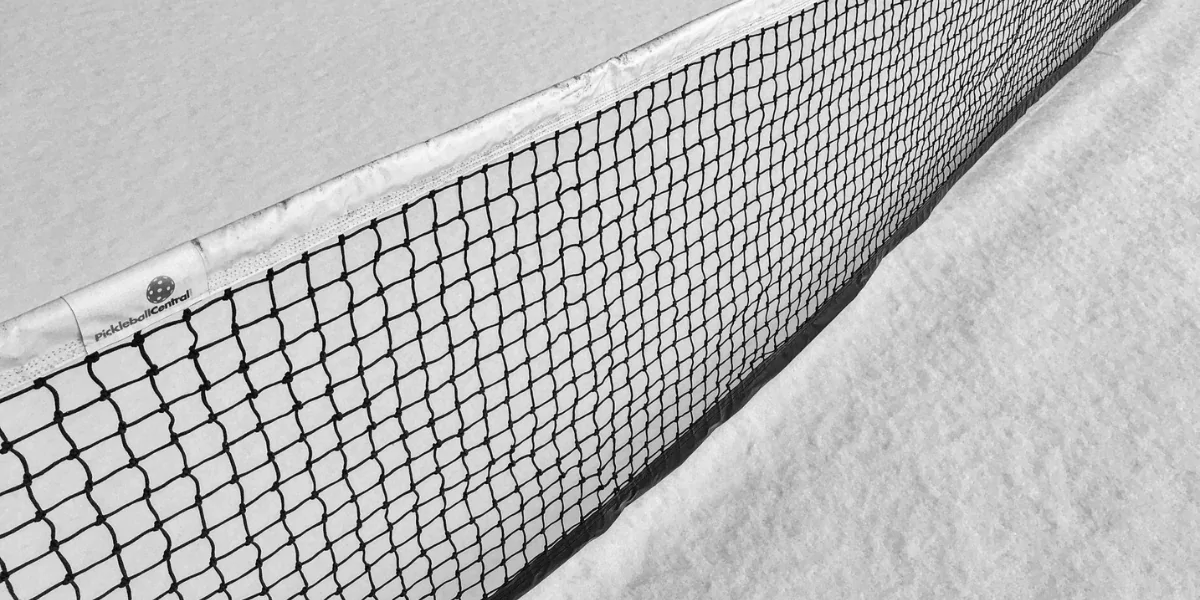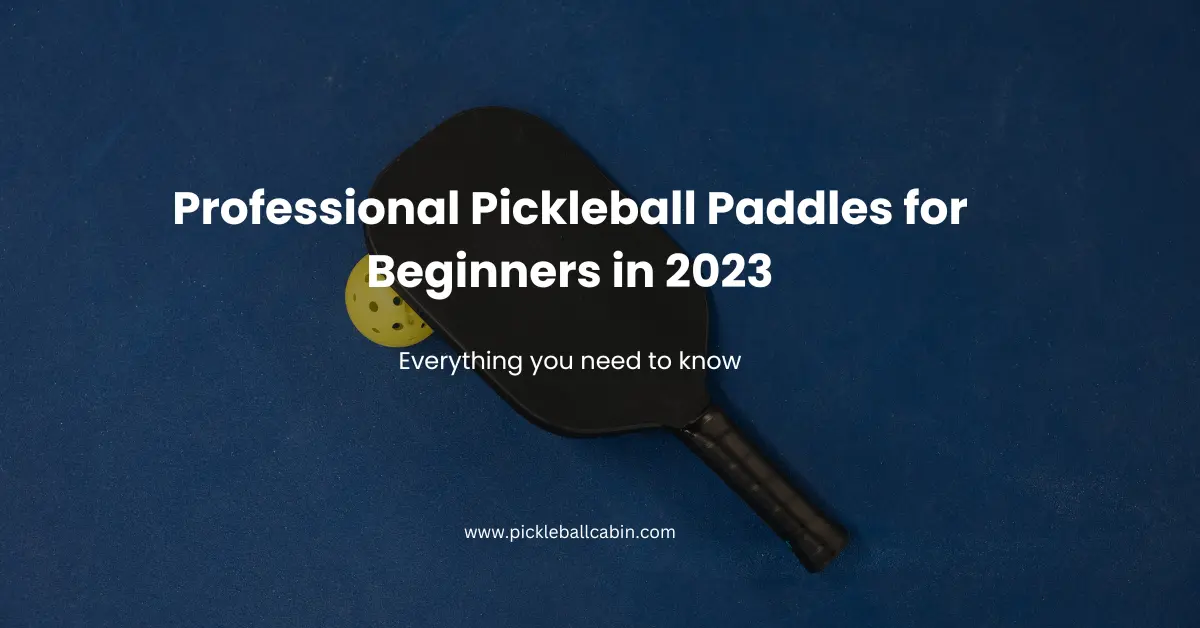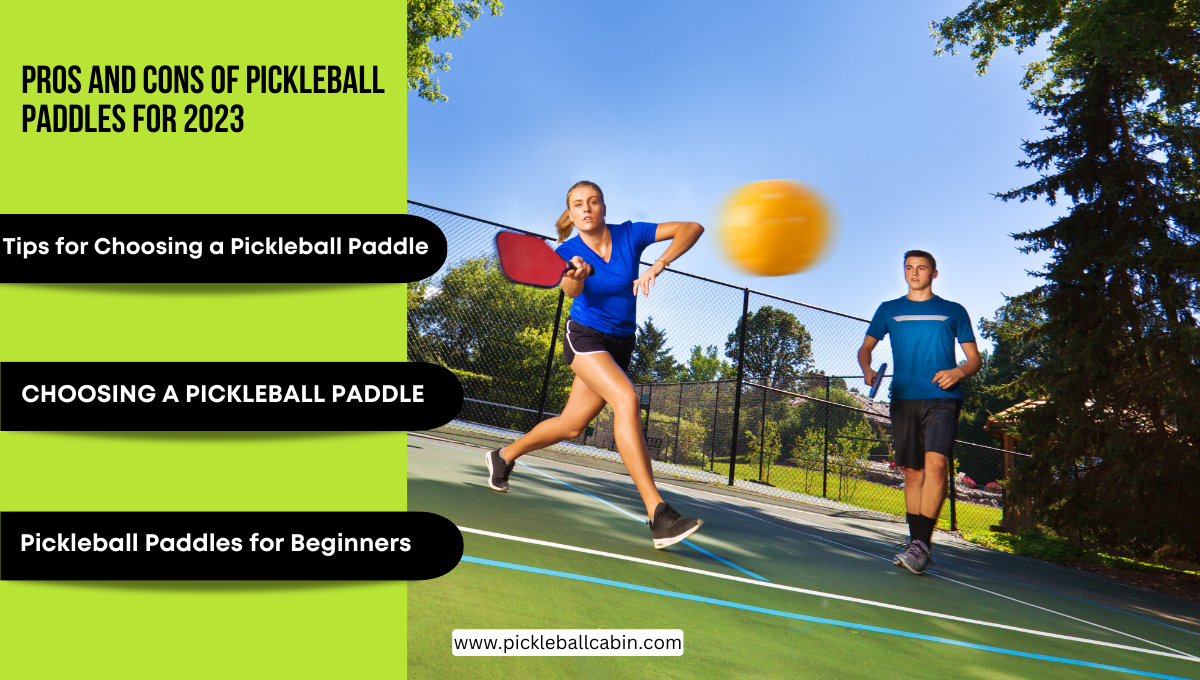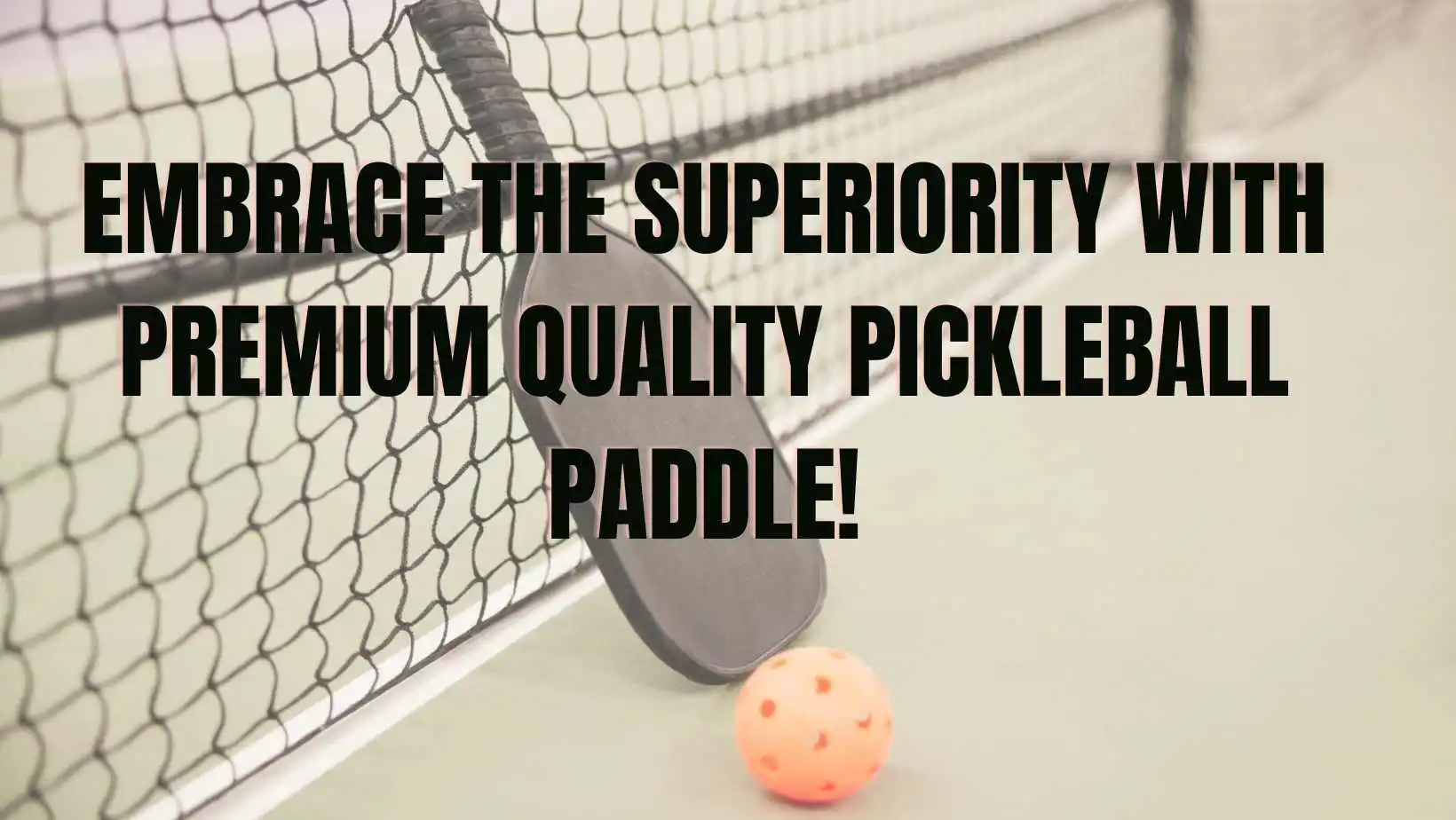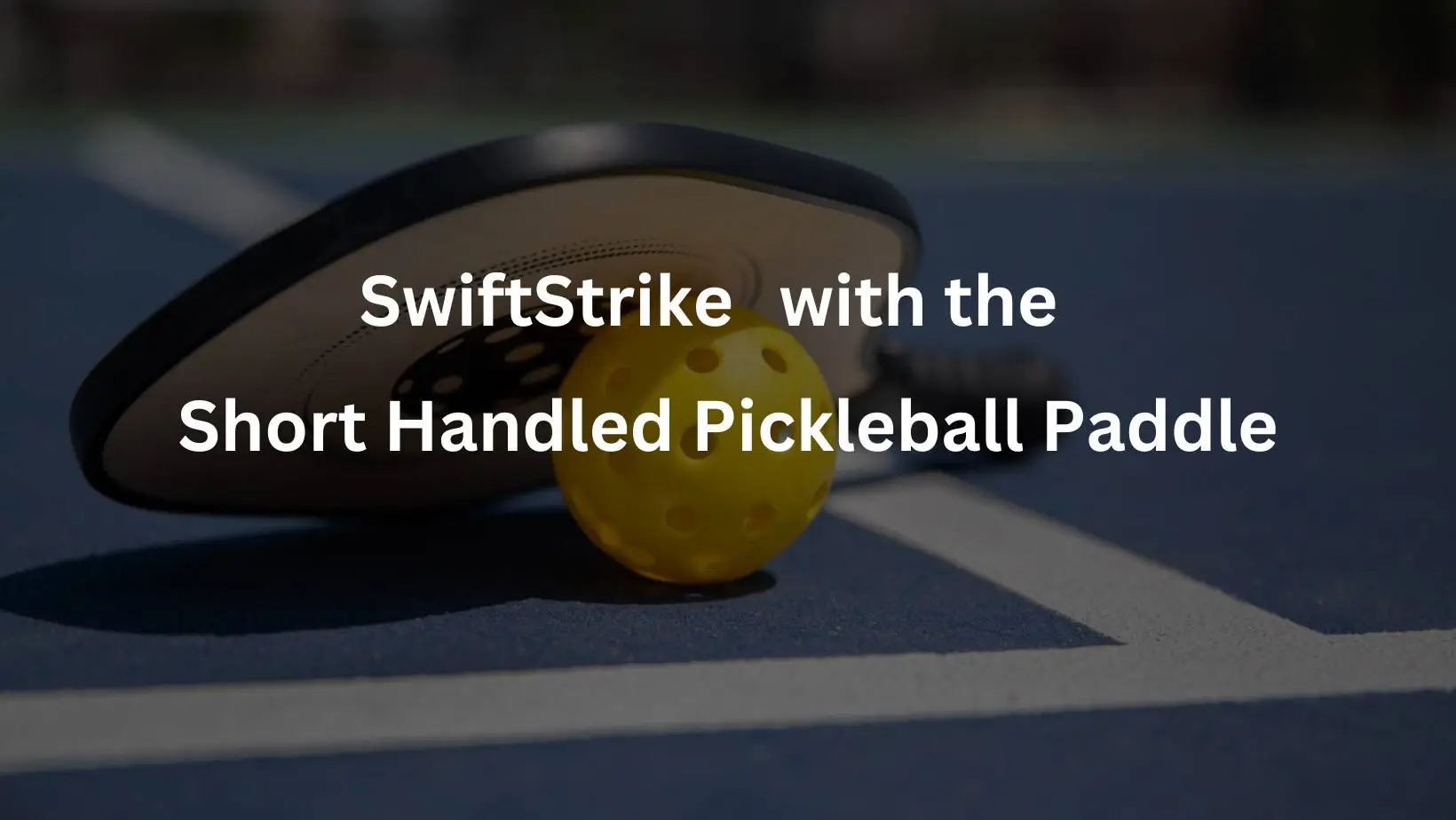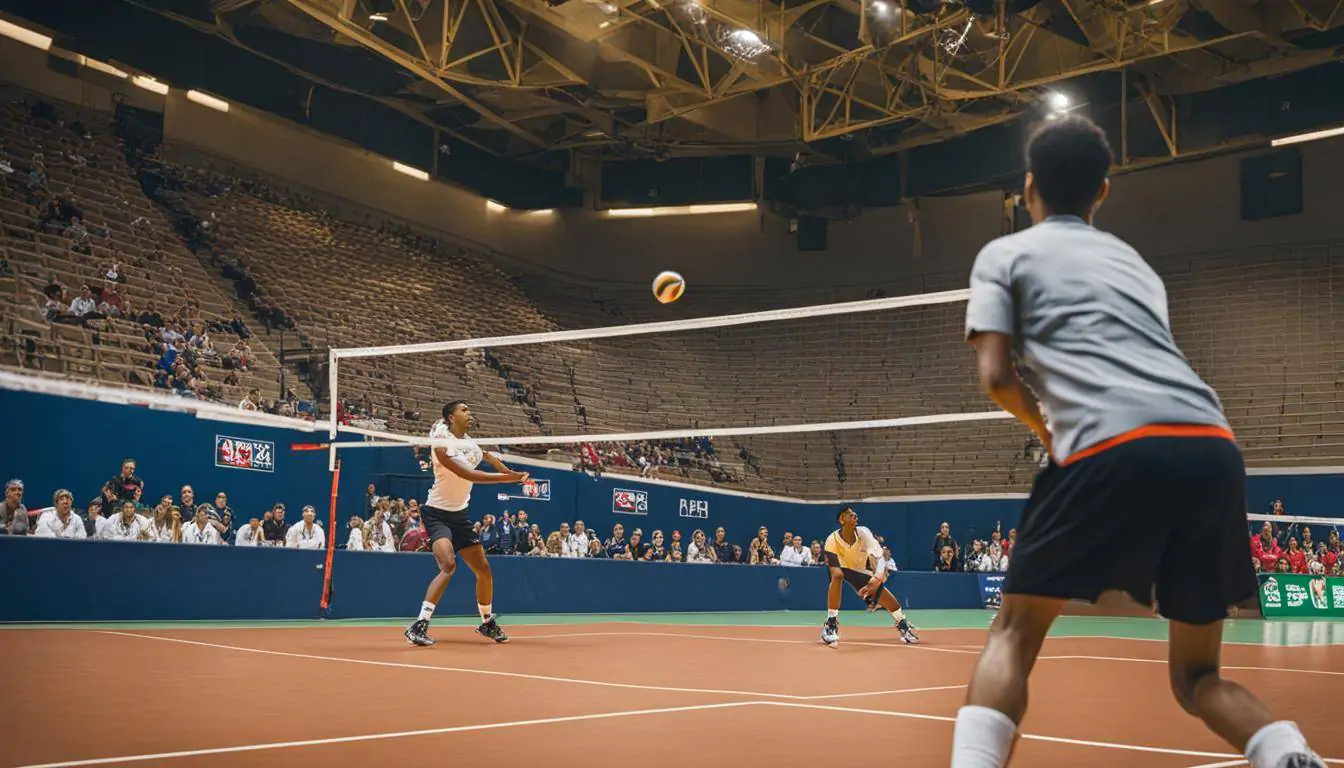Are you a left-handed pickleball player looking for the perfect paddle to enhance your game? Look no further! In the world of pickleball, where every move counts, mastering the game requires a keen understanding of your equipment.
From its unique design tailored for left handed players to the science behind its performance, we’ll unravel it all. As you read on, you’ll gain valuable insights that will not only enhance your skills on the court but also empower you to make informed decisions when choosing the perfect paddle.
Get ready to elevate your game and gain the upper hand with the ultimate tool for left handed pickleball players. Your journey to pickleball mastery starts here.
How to Play Pickleball If You Are Left-Handed
Playing pickleball if you are left-handed can be challenging, but also rewarding. You might face some difficulties and disadvantages, but you can also use some strategies and advantages to overcome them. Here are some tips and tricks on how to play pickleball if you are left-handed:
Grip Techniques for Left-Handed Players
One of the most important aspects of playing pickleball if you are left-handed is the grip technique. The grip technique is the way you hold and swing your paddle. It can affect your power, control, accuracy, and spin. There are different types of grips that you can use, depending on the type of shot and the situation. Some of the common types of grips are:
- Continental grip: The continental grip is the most basic and versatile grip. It is also called the hammer grip, because it is like holding a hammer. To use this grip, you place your hand on the 3rd bevel of the paddle, which is the one that is perpendicular to the paddle face. This grip allows you to hit both forehand and backhand shots with ease, and it is good for volleys, serves, and dinks. However, this grip can also limit your power and spin, and it can cause wrist strain if used too much.
- Eastern grip: The eastern grip is a more advanced and powerful grip. It is also called the handshake grip, because it is like shaking hands with the paddle. To use this grip, you rotate your hand slightly to the left, so that your index knuckle is on the 2nd bevel of the paddle, which is the one that is diagonal to the paddle face. This grip allows you to hit more powerful and spinny forehand shots, and it is good for drives, smashes, and drop shots. However, this grip can also make your backhand shots weaker and less consistent, and it can cause elbow strain if used too much.
- Two-handed grip: The two-handed grip is a more modern and stable grip. It is also called the double grip, because it involves using both hands on the paddle. To use this grip, you hold the paddle with your left hand as usual, and then you place your right hand on top of your left hand, or slightly below it.
This grip allows you to hit more stable and controlled backhand shots, and it is good for two-handed backhands, slices, and lobs. However, this grip can also reduce your reach and mobility, and it can cause shoulder strain if used too much.
You can experiment with different types of grips and see what works best for you. You can also switch between different grips depending on the shot and the situation. The key is to find a grip that is comfortable and effective for you, and that matches your playing style and preference.
Adjusting Your Game Strategy as a Left-Handed Player
Another important aspect of playing pickleball if you are left-handed is the game strategy. The game strategy is the way you plan and execute your shots and movements. It can affect your offense, defense, and positioning.
There are different factors that you should consider when adjusting your game strategy as a left-handed player, such as:
- Your opponent: One of the factors that you should consider when adjusting your game strategy as a left-handed player is your opponent. You should pay attention to your opponent’s hand, skill, style, and weakness.
For example, if your opponent is right-handed, you can try to hit cross-court shots to their backhand, which is usually their weaker side. If your opponent is left-handed, you can try to hit down-the-line shots to their forehand, which is usually their stronger side. If your opponent is skilled, you can try to play more defensively and wait for their mistakes.
If your opponent is unskilled, you can try to play more aggressively and force their errors. If your opponent is aggressive, you can try to play more patiently and counter their shots. If your opponent is passive, you can try to play more actively and pressure their shots. If your opponent has a weakness, you can try to exploit it and target it. - Your partner: Another factor that you should consider when adjusting your game strategy as a left-handed player is your partner. You should communicate and coordinate with your partner, and try to complement their hand, skill, style, and strength.
For example, if your partner is right-handed, you can try to position yourself on the left side of the court, which can give you more angles and options. If your partner is left-handed, you can try to position yourself on the right side of the court, which can give you more balance and symmetry. If your partner is skilled, you can try to support and follow them.
If your partner is unskilled, you can try to guide and help them. If your partner is aggressive, you can try to play more defensively and cover them. If your partner is passive, you can try to play more offensively and lead them. If your partner has a strength, you can try to enhance it and rely on it.
You can experiment with different factors and see what works best for you. You can also adapt to different situations and challenges. The key is to find a game strategy that is suitable and effective for you, and that matches your playing style and preference.
Understanding the Importance of a Left Handed Pickleball Paddle
As a left-handed player, finding a pickleball paddle that caters to your unique playing style is crucial. A left-handed paddle is specifically designed to address the needs and preferences of left-handed players, ensuring optimal performance and comfort on the court.
Left-handed players have a different grip and swing orientation compared to right-handed players. Therefore, using a paddle designed for right-handed players may provide a different level of control and maneuverability. A Left Handed Pickleball Paddle considers lefties’ specific requirements, allowing them to play at their best.
What is a Left-Handed Pickleball Paddle?
A left-handed pickleball paddle is a paddle that is designed specifically for left-handed players. It is not just a regular paddle that is flipped over, but a paddle that has some features that make it more suitable for lefties.
Design and Material of Left-Handed Pickleball Paddles
The design and material of a left-handed pickleball paddle can affect its performance, durability, and comfort. Some of the factors that you should consider when choosing a left-handed pickleball paddle are:
- Paddle shape: The shape of the paddle can influence the size of the sweet spot, the area on the paddle where you get the most power and control. Some common paddle shapes are classic or wide-body, which have a larger sweet spot, and elongated or blade, which have a smaller sweet spot but more reach. Left-handed players might prefer a paddle shape that matches their playing style and preference.
- Paddle length: The length of the paddle can affect the maneuverability and balance of the paddle. Longer paddles can give you more reach and power, but they can also be heavier and harder to control. Shorter paddles can give you more control and accuracy, but they can also limit your reach and power. Left-handed players might want to choose a paddle length that suits their skill level and comfort.
- Paddle width: The width of the paddle can affect the surface area and the weight of the paddle. Wider paddles can give you more surface area to hit the ball, but they can also be heavier and slower. Narrower paddles can give you more speed and agility, but they can also reduce your margin of error. Left-handed players might want to choose a paddle width that balances their needs and preferences.
- Paddle weight: The weight of the paddle can affect the swing speed and the impact of the paddle. Heavier paddles can give you more power and stability, but they can also cause more fatigue and strain. Lighter paddles can give you more speed and responsiveness, but they can also cause more vibration and shock. Left-handed players might want to choose a paddle weight that is comfortable and effective for them.
- Paddle material: The material of the paddle can affect the durability and the feel of the paddle. Some common materials used for pickleball paddles are wood, polymer, composite, and carbon fiber. Wood paddles are the cheapest and the heaviest, but they are also the least durable and the least responsive.
Polymer paddles are the most popular and the most affordable, but they are also the softest and the quietest. Composite paddles are the most versatile and the most customizable, but they are also the most expensive and the most noisy.
Carbon fiber paddles are the most advanced and the most lightweight, but they are also the most rigid and the most expensive. Left-handed players might want to choose a paddle material that matches their budget and their expectations.
The Importance of Grip in Left-Handed Pickleball Paddles
The grip is the part of the paddle that you hold in your hand. It is one of the most important aspects of a left-handed pickleball paddle, as it can affect your comfort, control, and performance. Some of the factors that you should consider when choosing a grip for your left-handed pickleball paddle are:
- Grip size: The grip size is the circumference of the grip. It can affect the fit and the feel of the grip in your hand. A grip size that is too small can cause you to squeeze the paddle too hard, which can lead to fatigue, cramps, and loss of control. A grip size that is too large can cause you to lose your grip on the paddle, which can lead to slips, errors, and injuries.
Left-handed players might want to choose a grip size that is comfortable and secure for them. The standard grip size for pickleball paddles is 4 inches, but you can also find paddles with smaller or larger grip sizes, or use replacement grips or overgrips to adjust the grip size to your liking. - Grip style: The grip style is the shape and the texture of the grip. It can affect the grip and the feel of the paddle in your hand. Some common grip styles are flat, beveled, or contoured. Flat grips are the simplest and the most common, but they can also be the most slippery and the least comfortable.
Beveled grips have angled edges that can help you align your hand and your paddle, but they can also be the most rigid and the least forgiving. Contoured grips have ergonomic curves that can fit your hand and your paddle, but they can also be the most complex and the most expensive. Left-handed players might want to choose a grip style that is suitable and comfortable for them. - Grip type: The grip type is the material and the coating of the grip. It can affect the durability and the feel of the grip in your hand. Some common grip types are leather, synthetic, or rubber. Leather grips are the most traditional and the most natural, but they can also be the most slippery and the least durable.
Synthetic grips are the most modern and the most varied, but they can also be the most synthetic and the least consistent. Rubber grips are the most durable and the most tacky, but they can also be the most heavy and the least breathable. Left-handed players might want to choose a grip type that is appropriate and comfortable for them.
Don’t Forget to Read: Grip Enhanced Pickleball Paddle: The Complete 2023 Buyer’s Guide
Do You Really Need a Left-Handed Pickleball Paddle?
You might be wondering if you really need a left-handed pickleball paddle, or if you can just use a regular paddle that is flipped over. The answer is that it depends on your personal preference and your level of play. Some of the pros and cons of using a left-handed pickleball paddle are:
- Pros:
- A left-handed pickleball paddle can give you more comfort and control, as it is designed to fit your hand and your paddle better.
- A left-handed pickleball paddle can give you more performance and advantage, as it is tailored to your playing style and preference.
- A left-handed pickleball paddle can give you more identity and pride, as it is a reflection of your uniqueness and skill.
- Cons:
- A left-handed pickleball paddle can be more expensive and harder to find, as it is less common and less available than regular paddles.
- A left-handed pickleball paddle can be more confusing and inconvenient, as it is different and incompatible with regular paddles.
- A left-handed pickleball paddle can be more limiting and restrictive, as it is less versatile and less adaptable than regular paddles.
Ultimately, the choice of whether to use a left-handed pickleball paddle or not is up to you. You should try out different paddles and see what works best for you. You might find that a left-handed pickleball paddle is exactly what you need, or you might find that a regular paddle is just fine for you.
Comparing Left-Handed and Right-Handed Pickleball Paddles
If you are curious about how left-handed and right-handed pickleball paddles differ, here are some of the main differences between them:
- Orientation: The most obvious difference between left-handed and right-handed pickleball paddles is the orientation of the paddle. A left-handed paddle is oriented for left-handed players, while a right-handed paddle is oriented for right-handed players. This means that the paddle face, the edge guard, the logo, and the grip are all aligned for the respective hand.
For example, a left-handed paddle will have the paddle face facing left, the edge guard on the right side, the logo on the left side, and the grip on the left side. A right-handed paddle will have the opposite orientation. - Balance: Another difference between left-handed and right-handed pickleball paddles is the balance of the paddle. The balance of the paddle is the distribution of weight between the head and the handle of the paddle. A left-handed paddle will have a balance that is optimized for left-handed players, while a right-handed paddle will have a balance that is optimized for right-handed players.
This means that the paddle will have a slight bias towards the dominant hand, which can affect the swing and the impact of the paddle. For example, a left-handed paddle will have a slightly heavier head and a slightly lighter handle, while a right-handed paddle will have the opposite balance. - Shape: A third difference between left-handed and right-handed pickleball paddles is the shape of the paddle. The shape of the paddle is the contour and the angle of the paddle face and the edge guard. A left-handed paddle will have a shape that is customized for left-handed players, while a right-handed paddle will have a shape that is customized for right-handed players.
For example, a left-handed paddle will have a slightly curved face and a slightly tilted edge guard towards the left, while a right-handed paddle will have the opposite shape.
You may also Like to read; Well Balanced Pickleball Paddle | Best Of Both Worlds In Power And Control
5 Differences in Left handed Pickleball Paddle VS Right-handed Pickleball Paddles
Here is a table that highlights the top five differences between left-handed and right-handed pickleball paddles, based on the information I found on the web.
| Difference | Left-Handed Pickleball Paddle | Right-Handed Pickleball Paddle |
|---|---|---|
| 1. Grip direction | The grip of a left-handed paddle is wrapped in the opposite direction of a right-handed paddle, to match the angle of the fingers of a left-handed player. This helps the left-handed player to have a better grip and control of the paddle. | The grip of a right-handed paddle is wrapped in the normal direction, to match the angle of the fingers of a right-handed player. This helps the right-handed player to have a better grip and control of the paddle. |
| 2. Spin effect | Left-handed players typically put different spin on the pickleball, as compared to right-handed players. This is because lefties hit the pickleball from a different angle because they are opposite-handed. This can affect the trajectory and bounce of the pickleball. | Right-handed players typically put different spin on the pickleball, as compared to left-handed players. This is because righties hit the pickleball from a different angle because they are opposite-handed. This can affect the trajectory and bounce of the pickleball. |
| 3. Forehand and backhand sides | Left-handed players have their forehand on the left side of the court and their backhand on the right side of the court. This means that they can hit more cross-court shots with their forehand and more down-the-line shots with their backhand. | Right-handed players have their forehand on the right side of the court and their backhand on the left side of the court. This means that they can hit more cross-court shots with their forehand and more down-the-line shots with their backhand. |
| 4. Partner compatibility | Left-handed players can have an advantage when playing with a right-handed partner in doubles, as they can cover more of the court with their forehands and create more angles and variety in their shots. However, they also need to communicate well with their partner and avoid hitting each other or getting in each other’s way. | Right-handed players can have an advantage when playing with a left-handed partner in doubles, as they can cover more of the court with their forehands and create more angles and variety in their shots. However, they also need to communicate well with their partner and avoid hitting each other or getting in each other’s way. |
| 5. Opponent strategy | Left-handed players can have an edge over right-handed opponents, as they are less common and less familiar to play against. They can exploit the weaknesses of right-handed players, such as their backhand or their tendency to favor the right side of the court. However, they also need to be aware of their own weaknesses and adjust their game accordingly. | Right-handed players can have a disadvantage against left-handed opponents, as they are more common and more familiar to play against. They can be exploited by the strengths of left-handed players, such as their forehand or their tendency to favor the left side of the court. However, they also need to be aware of their own strengths and adjust their game accordingly. |
I hope this table helps you understand the main differences and the reasons why left-handed and right-handed pickleball paddles are used and regulated.
How Manufacturers Cater to Left-Handed Players
You might be wondering how manufacturers cater to left-handed players, and what options are available for you. The truth is that not all manufacturers offer left-handed pickleball paddles, and some of them only offer a limited selection of models, colors, and sizes.
However, there are some manufacturers that do provide a variety of left-handed pickleball paddles, and some of them even allow you to customize your own paddle. Here are some of the ways that manufacturers cater to left-handed players:
- Offering left-handed versions of their regular paddles: Some manufacturers offer left-handed versions of their regular paddles, which means that they have the same design and material, but with a different orientation and balance. For example, ProLite offers left-handed versions of their popular models, such as the Titan Pro, the Rebel PowerSpin, and the SuperNova.
These paddles have the same features and specifications as their right-handed counterparts, but with a left-handed orientation and balance. This way, you can enjoy the same quality and performance of these paddles, but with a better fit and feel for your left hand. - Offering left-handed specific paddles: Some manufacturers offer left-handed specific paddles, which means that they have a unique design and material, and are only available for left-handed players. For example, ProXR offers left-handed specific paddles, such as the “The Story” Lefty 16 Paddle, which is a paddle that is designed by a left-handed player for left-handed players. This paddle has a unique shape, material, and grip that are optimized for left-handed players.
This paddle also has a special story behind it, which is explained in the next section. This way, you can enjoy a paddle that is made for you and by you, and that has a meaningful story behind it. - Offering custom-made paddles: Some manufacturers offer custom-made paddles, which means that they allow you to design and create your own paddle according to your preferences and specifications. For example, Selkirk offers custom-made paddles, which let you choose the shape, size, weight, color, and logo of your paddle.
You can also choose the material, the core, the surface, and the edge guard of your paddle. This way, you can enjoy a paddle that is tailored to your needs and wants, and that reflects your personality and style.
Exploring Options for Left-Handed Pickleball Paddles
As we have seen, playing pickleball if you are left-handed can be challenging, but also rewarding. You might face some difficulties and disadvantages, but you can also use some strategies and advantages to overcome them. One of the ways to improve your game and enjoy your experience is to explore the options for left-handed pickleball paddles. There are many options available for you, depending on your budget, your expectations, and your personality. Here are some of the options that you can explore:
ProXR “The Story” Lefty 16 Paddle
One of the options that you can explore for left-handed pickleball paddles is the ProXR “The Story” Lefty 16 Paddle. This is a paddle that is designed by a left-handed player for left-handed players. It has a unique shape, material, and grip that are optimized for left-handed players. It also has a special story behind it, which is explained below.
The ProXR “The Story” Lefty 16 Paddle is a paddle that is inspired by the story of a left-handed player named Steve Wong. Steve Wong is a former professional table tennis player who switched to pickleball in 2010. He is also the founder and owner of Onix Sports, a leading pickleball equipment company. Steve Wong is a left-handed player who faced many challenges and disadvantages in his pickleball career, such as finding the right paddle, playing against right-handed opponents, and dealing with injuries. He decided to create his own paddle that would suit his needs and preferences, and that would reflect his story and passion. He partnered with ProXR, a company that specializes in ergonomic grips, and created the ProXR “The Story” Lefty 16 Paddle.
The ProXR “The Story” Lefty 16 Paddle is a paddle that has a unique shape, material, and grip that are optimized for left-handed players. The paddle has a classic or wide-body shape, which gives it a large sweet spot and a wide surface area. The paddle has a carbon fiber surface, which gives it a smooth and durable finish. The paddle has a polymer core, which gives it a soft and quiet feel. The paddle has a weight range of 7.4-10.5 ounces, which gives it a balanced and comfortable feel. The paddle has a grip size of 4 inches, which gives it a standard and secure fit.
The most distinctive feature of the ProXR “The Story” Lefty 16 Paddle is the grip. The grip is an ergonomic grip that is designed to fit the natural shape and movement of the left hand. The grip has a contoured shape, which gives it a snug and comfortable fit. The grip has a beveled edge, which gives it a precise and consistent alignment. The grip has a rubber material, which gives it a tacky and stable feel. The grip also has a performance-tac cushion, which gives it a soft and shock-absorbing feel.
The ProXR “The Story” Lefty 16 Paddle is a paddle that is not only optimized for left-handed players, but also inspired by a left-handed player. The paddle has a black and white color scheme, which represents the contrast and the challenge of being a left-handed player. The paddle has a logo that says “The Story”, which represents the story and the passion of Steve Wong. The paddle also has a number 16 on the paddle face, which represents the year 2016, when Steve Wong created his own paddle and started his journey as a left-handed player.
The ProXR “The Story” Lefty 16 Paddle is a paddle that is suitable and effective for left-handed players of all skill levels and playing styles. It is a paddle that can give you more comfort, control, performance, and pride. It is a paddle that can help you overcome the challenges and disadvantages of being a left-handed player, and use them as your strengths and advantages. It is a paddle that can help you tell your own story and express your own passion as a left-handed player.
Customizing Your Own Left-Handed Pickleball Paddle
Another option that you can explore for left-handed pickleball paddles is customizing your own paddle. This is an option that allows you to design and create your own paddle according to your preferences and specifications. This is an option that gives you more freedom and creativity, and more satisfaction and enjoyment.
Customizing your own left-handed pickleball paddle can be done in different ways, depending on the manufacturer and the service. Some of the ways that you can customize your own paddle are:
- Choosing the shape, size, weight, color, and logo of your paddle: This is the most basic and common way of customizing your own paddle. You can choose the shape, size, weight, color, and logo of your paddle from a range of options provided by the manufacturer. For example, Selkirk offers this service on their website, where you can choose from different shapes (classic, elongated, or blade), sizes (small, medium, or large), weights (light, mid, or heavy), colors (solid, gradient, or pattern), and logos (standard, custom, or none) of your paddle. You can also preview your paddle and see how it looks before you order it.
- Choosing the material, the core, the surface, and the edge guard of your paddle: This is a more advanced and specific way of customizing your own paddle. You can choose the material, the core, the surface, and the edge guard of your paddle from a range of options provided by the manufacturer. For example, Selkirk also offers this service on their website, where you can choose from different materials (polymer, composite, or carbon fiber), cores (polymer honeycomb, aluminum honeycomb, or nomex honeycomb), surfaces (fiberglass, carbon fiber, or graphite), and edge guards (standard, thin, or edgeless) of your paddle. You can also see the specifications and the benefits of each option before you order it.
- Choosing the grip size, style, type, and color of your paddle: This is a more detailed and personal way of customizing your own paddle. You can choose the grip size, style, type, and color of your paddle from a range of options provided by the manufacturer or by a third-party provider. For example, ProLite offers this service on their website, where you can choose from different grip sizes (4 inches, 4.125 inches, or 4.25 inches), styles (flat, beveled, or contoured), types (leather, synthetic, or rubber), and colors (black, white, or custom) of your paddle. You can also see the features and the advantages of each option before you order it.
Customizing your own left-handed pickleball paddle can be a fun and rewarding process, but it can also be a costly and time-consuming one. You should be prepared to pay more and wait longer for your paddle, as it is a bespoke and special order. You should also be careful and confident with your choices, as it is a final and personal order. You should also be aware and respectful of the rules and regulations of the pickleball industry, as some options might not be allowed or approved by the USAPA or other governing bodies.
Also Read; Boost Your Game With Textured Pickleball Paddle
Some More Options for Left Handed Pickleball Paddle Players
Gamma X55 Left Handed Pickleball Paddle
- Features a 7-ply maple wood construction with a flared grip and a smooth finish
- Weighs 7.5 ounces and has a head size of 7.5 inches
- Comes with a lifetime warranty
Head Radical Tour Pickleball Paddle – Left Handed
- Features a 5-ply blend of composite materials with a flared grip and a matte finish
- Weighs 7.6 ounces and has a head size of 7.5 inches
- Comes with a 2-year warranty
Selkirk Amped S2 Pickleball Paddle – Left Handed
- Features a 7-ply maple wood construction with a flared grip and a textured finish
- Weighs 7.8 ounces and has a head size of 7.75 inches
- Comes with a lifetime warranty
GAMMA SX500 Left Handed Pickleball Paddle
- Features a 5-ply composite construction with a flared grip and a smooth finish
- Weighs 7.6 ounces and has a head size of 7.5 inches
- Comes with a lifetime warranty
HEAD Radical Midplus Pickleball Paddle – Left Handed
- Features a 5-ply blend of composite materials with a flared grip and a matte finish
- Weighs 7.8 ounces and has a head size of 7.75 inches
- Comes with a 2-year warranty
These are just a few examples of the many Left Handed Pickleball Paddles available on the market. When choosing a paddle, it is important to consider your individual needs and preferences. Some factors to consider include the paddle’s weight, the head’s size, and the construction material. It is also important to try out a few different paddles to see which one feels the most comfortable for you.
Final Thoughts
In Short, mastering the game of pickleball as a left handed player hinges on understanding your equipment. Choosing the best left-handed pickleball paddle for you can be a challenging, but also rewarding, task. You should consider various factors, such as the design, material, grip, price, and availability of the paddle.
You should also explore various options, such as the left-handed versions of regular paddles, the left-handed specific paddles, and the custom-made paddles. You should also experiment with different paddles and see what works best for you. You should also adjust your grip technique and your game strategy as a left-handed player. The key is to find a paddle that is comfortable and effective for you, and that matches your playing style and preference.
We hope that this article has helped you understand the left-handed pickleball paddle better, and that it has given you some tips and tricks on how to play pickleball if you are left-handed. We hope that you have enjoyed reading this article, and that you have learned something new and useful from it. We hope that you will try out some of the options and suggestions that we have provided, and that you will find the best left-handed pickleball paddle for you. We hope that you will have fun and success in your pickleball journey, and that you will share your story and passion with others.
FAQ for Left Handed Pickleball Paddle
1. Why is it essential for left-handed players to use a Left Handed Pickleball Paddle?
A Left Handed Pickleball Paddle is crucial for left-handed players because it caters to their unique grip and swing orientation. This paddle ensures optimal performance and comfort on the court for left-handed players.
2. What should left-handed players consider when choosing a Left Handed Pickleball Paddle?
Left-handed players should consider several key features when choosing a Left Handed Pickleball Paddle. These include grip design, weight and balance, face surface, core material, and noise and vibration-dampening technology.
3. How does the grip design of a Left Handed Pickleball Paddle benefit left-handed players?
The grip design of the Left Handed Pickleball Paddle benefits left-handed players by offering an ergonomic shape that fits naturally in their hands. This provides a comfortable and secure hold, allowing for better control and maneuverability during the game.
4. Why is it essential for left-handed players to pay attention to their opponent’s weaknesses?
Left-handed players should pay attention to their opponent’s weaknesses because their left-handed playing style can throw off the rhythm and expectations of right-handed opponents. This allows left-handed players to exploit their opponent’s vulnerabilities and gain an edge.
